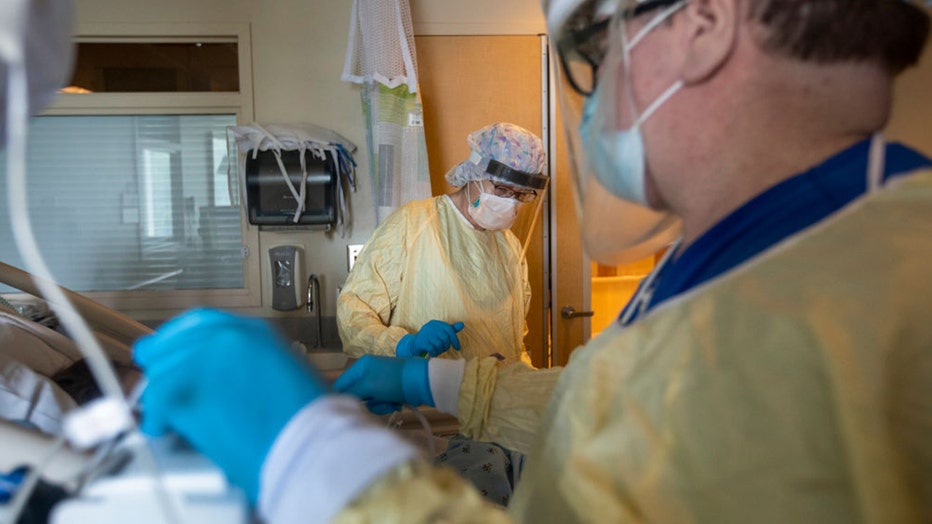CDC: US COVID-19 cases up 43%, 83% of counties see ‘moderate to high’ spread
The rolling seven-day average of new COVID-19 cases sharply increased over the past week and the overwhelming majority of counties in the United States are now seeing "moderate to high" transmission rates of the novel coronavirus, according to data from the U.S. Centers for Disease Control and Prevention.
During a White House COVID-19 press briefing on Thursday, Dr. Rochelle Walensky, director of the CDC, outlined recent increases in COVID-19 deaths, cases and hospitalizations across the country.
"Yesterday, CDC recorded 103,445 new cases of COVID-19. Our seven-day average is about 89,463 cases per day. This represents an increase of 43% from the prior seven-day average. The seven-day average of hospital admissions is about 7,348 per day, an increase of about 41% from the prior seven-day period. And seven-day average daily deaths have also increased to 381 per day. An increase of more than 39% from the previous seven-day period," Walensky said.
On Aug. 3 alone, the CDC reported 614 new COVID-19 deaths, Walensky added.

FILE - RNs reposition a patient in the ICU inside Little Company of Mary Medical Center Friday, July 30, 2021 in Torrance, CA.
RELATED: Moderna: Vaccine 93% effective up to 6 months but booster likely needed before winter
Overall, 83% of the counties across the country are experiencing moderate or high transmission rates, "with delta variants continuing to be the predominant circulating virus," Walensky continued.
The CDC listed the delta variant as a variant of concern in the U.S. and noted that it is substantially more transmissible than previous variants.
The delta variant of the novel coronavirus currently accounts for 93% of cases in the United States, according to an estimate by the CDC.
CDC data shows the primary delta variant, known as the lineage B1.617.2, makes up 83.4% of COVID-19 cases. But when combined with its sublineages, that number grows to 93.4%.
RELATED: COVID-19: What to know about symptoms, the delta variant and vaccines
The AY.3 sublineage equals 9.1% of cases, the AY.2 makes up 0.8% and the AY.1 accounts for the remaining 0.1%.
The CDC calculated the numbers through its national genomic surveillance program, which is tasked with identifying new and emerging COVID-19 variants. Using data from genomic sequencing, the CDC groups sequences with similar genetic changes associated with important epidemiological and biological events into lineages.
New evidence from the CDC released on July 29 revealed that the delta variant can be as contagious as chickenpox. A surge in new cases being spurred on by the variant of concern has led the CDC and federal health officials to reverse their recommendations on mask-wearing indoors.
The CDC changed course on masks on July 27, recommending that even vaccinated people return to wearing facial coverings indoors in parts of the U.S. where the delta variant of the coronavirus is fueling infection surges.
RELATED: Delta variant accounts for 93% of US COVID-19 cases, CDC estimates
Citing new information about the variant’s ability to spread among vaccinated people, the CDC also recommended indoor masks for all teachers, staff, students and visitors at schools nationwide, regardless of vaccination status.
The CDC noted that vaccinated people are 10 times less likely to get seriously sick from COVID-19, and three times less likely to get infected. The agency has stressed that unvaccinated people account for more than 99% of recent hospitalizations and deaths in data collected between January and June.
Walensky said officials are working to collect more recent data since the delta variant began driving the surge. But she said unvaccinated people still make up the overwhelming majority of hospitalizations and deaths.
"Those at highest risk remain people who have not yet been vaccinated. Now is the time to get vaccinated. We know these vaccines are working and we know they save lives," Walensky said.
RELATED: New COVID-19 cases in US surpassed 100K for past 2 days
Most new infections in the U.S. continue to be among unvaccinated people. Real-world evidence from multiple countries shows vaccine protection remains strong against the delta variant, particularly against hospitalizations and deaths.
But so-called breakthrough infections, while rare, can occur in vaccinated people — as none of the shots are 100% effective. The vast majority of such cases cause mild or no symptoms, but new research shows they can carry about the same amount of the coronavirus as those who did not get the shots.
To date, just under 50% of the total U.S. population is fully vaccinated.
Some countries have already begun offering a third booster dose to vulnerable groups with weak immune systems, though U.S. health authorities have not yet called for boosters. Moderna and Pfizer are studying a variety of booster strategies.
Kelly Hayes contributed to this report. This story was reported from Los Angeles.

